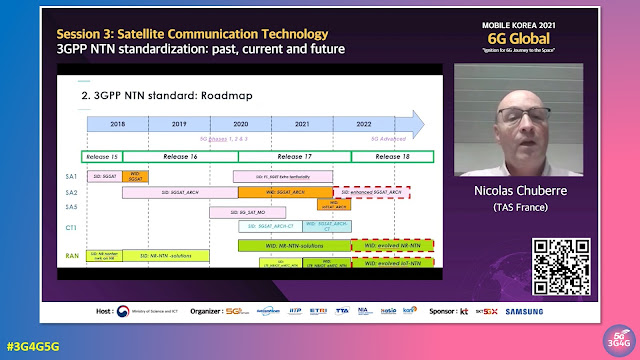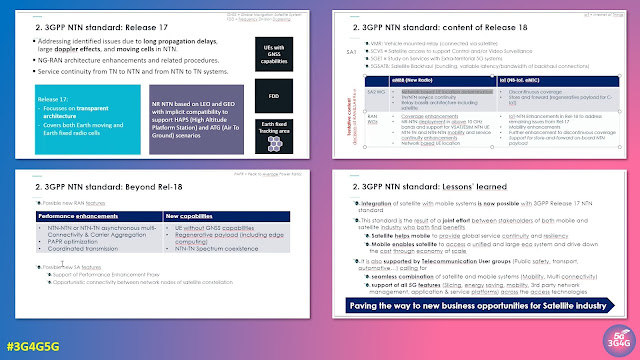We have looked at 5G Non Terrestrial Networks (NTN) in many different posts in our blogs. If you are new to this topic then this tutorial with a video is a good place to start or just follow this IEEE Comsoc article or this short update from R&S here.
Nicolas Chuberre is the rapporteur of the NR_NTN_solutions work item (TSG RAN) and of the FS-5GET study item (WG SA1) from Thales Alenia Space. In the October 2021 issue of 3GPP Highlights newsletter, he along with Munira Jaffar, Lead delegate representing EchoStar and Hughes Standards in ESOA (EMEA Satellite Operators Association) Standards Working Group, wrote a summary of 'Status of NTN & Satellite in 3GPP Releases 17 & 18'.
Quoting from the article:
The approval of normative activities on Non-Terrestrial Networks (NTN) in Rel-17 has generated growing interest in the topic. The Rel-17 NTN work items are supported by a wide range of vendors (terminal, chipset, network), as well as service providers from both the mobile and space industries and vertical user groups including ESOA.
The Rel-17 NTN and satellite work items in Technical Specification Group (TSG) RAN and TSG SA have been progressing towards the goal of satellite inclusion in 3GPP technical specifications. The focus is on transparent payload architecture with FDD systems where all UEs are assumed to have GNSS capabilities. The normative phase includes adaptation to the physical & access layer aspects, radio access network and system architecture, radio resource management, and RF requirements for targeted satellite networks operating at LEO, MEO or GEO orbits.
With an expected completion date of March 2022, the 3GPP Rel-17 specifications will support New Radio (NR) based satellite access deployed in FR1 bands serving handheld devices for global service continuity. Equally exciting, the 3GPP Rel-17 specification will support NB-IoT and eMTC based satellite access to address massive Internet of Things (IoT) use cases in areas such as agriculture, transport, logistics and many more.
This joint effort between mobile and satellite industries will enable the full integration of satellite in the 3GPP ecosystem and define a global standard for future satellite networks. This will address the challenges of reachability and service continuity in unserved/underserved areas, enhance reliability through connectivity between various access technologies, and improve network resilience and dependability in responding to natural and manmade disasters.
Upon completion of Rel-17 the long-awaited standard for satellite networks serving handheld devices should be in place by 2022, with commercial product availability expected sometime in 2024. Including satellite as part of the 3GPP specifications will support the promise of worldwide access to 5G services and drive explosive growth in the satellite industry.
Looking ahead, ESOA members and other NTN stakeholders have started discussions during the 3GPP Rel-18 June workshop and are continuing to work on a further list of enhancements for both NR-NTN and IoT-NTN to be considered in Rel-18. Plans are also underway to further define the enablers for NR based satellite access in bands above 10 GHz to serve fixed and moving platforms (e.g., aircraft, vessels, UAVs) as well as building- mounted devices (e.g., businesses and premises). The goal of these efforts is to further optimize satellite access performance, address new bands with their specific regulatory requirements, and support new capabilities and services as the evolution of 5G continues.
At Mobile Korea 2021, Nicolas Chuberre gave a talk on '3GPP NTN standardization: past, current and future'. The talk nicely summarizes Release-17 progress and the features planned for 3GPP Release-18. His talk is embedded below:
Related Posts:
- Free 6G Training: Huawei explains Perspectives and Challenges of 6G-NTN
- Connectivity Technology Blog: OneWeb presents their Vision for LEO Satellites and 6G Connectivity
- Connectivity Technology Blog: SoftBank to Promote Non-Terrestrial Network (NTN) Solutions
- Connectivity Technology Blog: 5G Ready' OneWeb Megaconstellation is Getting Ready for Commercial Launch
- Connectivity Technology Blog: ITU Satellite Webinars 2020
- Connectivity Technology Blog: OneWeb has Global Connectivity Ambitions
- Connectivity Technology Blog: R&S Technical Explainer on 3GPP 5G Non Terrestrial Networks (NTN)
- IEEE Comsoc: Connectivity From Top to Bottom
- The 3G4G Blog: An Introduction to Non-Terrestrial Networks (NTN)




No comments:
Post a Comment